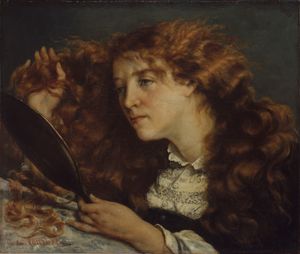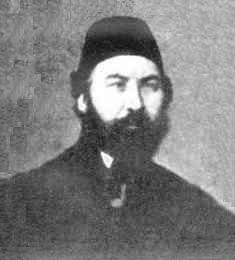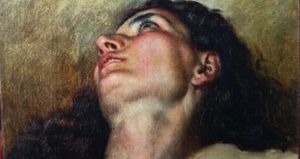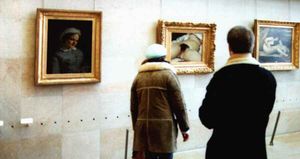نشأة العالم
| L'Origine du monde | |
|---|---|
 | |
| الفنان | گوستاڤ كوربيه |
| السنة | 1866 |
| الوسط | زيت على كناڤاه |
| الأبعاد | 46 cm × 55 cm (18 in × 22 in) |
| الموقع | متحف أوراسي، پاريس |
نشأة العالم (بالفرنسية: L'Origine du monde، بالإنگليزية: The Origin of the World)، هي لوحة زيت على كناڤاه للفنان الفرنسي گوستاڤ كوربيه، رسمها عام 1866. تصور اللوحة مشهداً مقرباً للعضو جنسي وبطن امرأة عارية، مستلقية على سرير مفتوحة الساقين. إبراز تأطير الجسد العاري، مع وضع الرأس والذراعين وأسفل الساقين خارج الرؤية، يؤكد على الإثارة الجنسية للعمل.
وصف اللوحة
تصور اللوحة امرأة شبه عارية مستلقية على سرير ويظهر عن قرب عضوها الجنسي وجذعها. يظهر كذلك الفخذان مفتوحان، وتغطي أعلى الجذع بقماش بما يسمح فقط برؤية جزء من ثديها الأيمن دون الرقبة والوجه. على الرغم من أن العمل لم يعرض للعموم قبل نهاية القرن العشرين، غير أنه كان معروفاً من قبل المعلقين والنقاد الفنيين والأدبيين في العالم وقت إنجازه وخاصة من خلال ماكسيم دو كامب الذي وصفه بالكلمات التالية[1] : "في حمام شخصية العمل المجهولة، نرى لوحة صغيرة مخبأة تحت حجاب أخضر. عندما أزيل الحجاب، كان من المذهل أن نرى امرأة بالحجم الطبيعي، بشكل مواجه (...) رسمت بشكل فائق البراعة، أو مشغولة بحب، كما يقول الإيطاليون، وتقدم الكلمة الأخيرة للنزعة الواقعية. ولكن، بسبب نسيان لا يمكن تصوره، فقد أهمل الحرفي الذي رسم نموذجه الحي تصوير القدمين والساقين والفخذين والبطن والوركين والصدر واليدين والذراعين والكتفين".
التاريخ
هوية الموديل
كانت الموديل المفوضل لكوربيه حين أنجز هذه اللوحة امرأة شابة تدعى جوانا هيفرنان المعروفة باسم "جو". وكان حبيبها الرسام الأمريكي المعجب بعمل كوربيه جيمس ويسلر قد قدمها إليه.
كان كوربيه في عام 1866 يعمل على إنجاز لوحة أخرى تدعى "الجميلة الإيرلندية" متخذاً هيفرنان موديلاً. وأنجز كوربيه أربع لوحات لهذه السيدة التي يشار إليها في بعض الأحيان كموديل محتمل للوحة "نشأة العالم"، الأمر الذي يفسر الانفصال الحاد بين كوربيه وويسلر بعد وقت قليل من إنهاء العمل[2]. عاد ويسلر فيما بعد إلى الولايات المتحدة تاركاً وصية لهيفرنان. وذلك على الرغم من اختلاف لون شعر "جو" الأحمر عن لون شعر العانة القاتم الذي يظهر في اللوحة.
من ناحية أخرى، وفي كتابه التاريخي المعنون "نشأة العالم، قصة لوحة گوستاڤ كوربيه" المنشور عام 2004[3]، يلقي تييري سافاتييه بظلال من الشك على هذه الفرضية مقدماً جملة افتراضات بينها أن يكون نموذج اللوحة صورة فوتوغرافية. وفي الطبعة الرابعة من الكتاب عام 2009، أضاف سافاتييه خاتمة تطرح فرضية تنص على أن المرأة نموذج للوحة كانت حاملاً وقت تم رسمها مستدلاً على ذلك بشكل بطنها[4].

بعد تييري سافاتييه، قدّم المؤرخ جيرار ديزانجيس عام 2011[5] فرضية أخرى تقول بأن السيدة يمكن أن تكون جان دو توربيه (الملقبة بـ"سيدة البنفسج") عشيقة الدبلوماسي التركي خليل بك الذي طلب رسم "نشأة العالم".ومع ذلك، فإن كلا المؤلفين قد أشار أنه لا يملك شهادات من تلك الحقبة يمكنها أن تدعم هذه الفرضية.
تبنّت روايتان فرضية أن نموذج اللوحة هو جوانا هيفرنان. سمّى الناقد الفني برنار تيسيدر، في روايته "رواية النشأة" المنشورة عام 1996 والتي تلعب فيها اللوحة نفسها الشخصية الرئيسية، نموذج المرأة التي رسمت عنها جوانا هيفرنان. أما الروائية كريستين أوريان فتقدم في روايتها "كنت أصل العالم" المنشورة عام 2000 جوانا هيفرنان كراوية للقصة وهي كانت عشيقة كوربيه ونموذج لللوحة الشهيرة.
المالكون

يعزى طلب إنجاز لوحة "نشأة العالم" إلى خليل شريف پاشا، وهو دبلوماسي تركي وسفير سابق للدولة العثمانية لدى أثينا وسانت پطرسبورگ خلال فترة من حياته قضاها في پاريس. بعد أن عرّفه الناقد الأدبي الفرنسي شارل أوگستان سانت-بوف إلى كوربيه، قام خليل بك بتكليفه برسم لوحة يضمها إلى مجموعته الشخصية من اللوحات الجنسية التي كانت تضم من بين أعمال أخرى، لوحات "الحمام التركي" لجان أوگست دومينيك آنگر (1862) و"النائمات" لكوربيه من عام 1866. تعرض خليل بك للإفلاس بسبب ديونه التي راكمها لعب القمار وبدأ نتيجة لذلك ببيع مجموعته الفنية فحصل تاجر قطع فنية قديمة يدعى أنطوان دو لا نارد على "نشأة العالم". فيما بعد، شاهد الكاتب الفرنسي الشهير أدموند دو گونكور اللوحة في محل التاجر عام 1898[6]. وتقول فرضية أخرى أن اللوحة كانت بين مجموعة إميل فيال حتى عام 1912 ثم انتهت بطريقة ما في معرض برنهيم-جيون الباريسي المعروف حتى عام 1913 حيث تم شراؤها في 16 يونيو من قبل البارون هيرزوگ الذي لم يكن بحسب الرسام الفرنسي روبير فيرنييه، سوى البارون فرانسوا دو هاتفاني الذي نقلها إلى بودابست وبقيت محفوظة هناك حتى الحرب العالمية الثانية. وخلال الحرب خبأت اللوحة مع لوحة أخرى لكوربيه هي "قلعة بلوناي". وهذه الأخيرة انتقلت في وقت لاحق إلى ملكية متحف الفنون الجميلة في بودابست.
آخر شخص امتلك اللوحة كان المحلل النفسي الفرنسي جاك لاكان مع شريكته الممثلة سيلفيا باتاي في عام 1955 وعرضها في منزله الريفي في ضاحية "إيفلين" قرب باريس. وبسبب اختفاء غطاء اللوحة الأصلي، فقد طلب لاكان من شقيق زوجته الفنان أندريه ماسون أن يصنع إطاراً مزدوجاً جديداً وأن يرسم عملاً آخر فوق الإطار. أنجز ماسون نسخة سريالية عن "نشأة العالم" عنونها "أرض إيروسيّة"[7]. أنتجت نسخة عن اللوحة في عام 1974 في مقال مصور لبرادلي سميث (1910-1997) كتب مقدمته الرسام والروائي الأمريكي هنري ميلر، ووضعت لها عنوان "Torse"[8].
أتيح للجمهور الأمريكي أن يشاهد لوحة "نشأة العالم" للمرة الأولى خلال معرض فني مخصص لكوربيه في متحف بروكلين عام 1988 وعرضت أيضاً في فرنسا عام 1992 في معرض "ماسون" في أورنانز. بعد وفاة لاكان عام 1981 وزوجته سيلفيا عام 1993، وافقت وزارة الاقتصاد والمالية الفرنسية أن ينتقل العمل إلى متحف أورسيه عام 1995.
عملاً استفزازياً
During the 19th century, the display of the nude body underwent a revolution whose main activists were Courbet and Manet. Courbet rejected academic painting and its smooth, idealised nudes, but he also directly recriminated the hypocritical social conventions of the Second Empire, where eroticism and even pornography were acceptable in mythological or oneiric paintings.
Courbet later insisted he never lied in his paintings, and his realism pushed the limits of what was considered presentable. With L'Origine du monde, he has made even more explicit the eroticism of Manet's Olympia. Maxime Du Camp, in a harsh tirade, reported his visit to the work's purchaser, and his sight of a painting "giving realism's last word".[9]
By the very nature of its realistic, graphic nudity, the painting still has the power to shock and triggers censorship.
Although moral standards and resulting taboos regarding the artistic display of nudity have changed since Courbet, owing especially to photography and cinema, the painting remained provocative. Its arrival at the Musée d'Orsay caused high excitement. According to postcard sales, L'Origine du monde is the second most popular painting in the Musée d'Orsay, after Renoir's Bal du moulin de la Galette.[10]
Some critics maintain that the body depicted is not (as has been argued) a lively erotic portrayal of a female but of a corpse: "L’Origine does not represent a full female body but rather a slice of one, cut off by the frame [...]. The pallidness of the skin and the mortuary gauze surrounding the body suggest death."[11]
التأثير
The explicitness of the picture may have served as an inspiration, albeit with a satirical twist, for Marcel Duchamp's last major work, Étant donnés (1946–1966), a construction also featuring the image of a woman lying on her back with her legs spread.[12]
In 1989, French artist Orlan created the cibachrome L'origine de la guerre (The Origin of War), a male version of L'origine du monde showing a penile erection.[13]
In February 1994, the novel Adorations perpétuelles (Perpetual Adorations) by Jacques Henric reproduced L'Origine du monde on its cover. Police visited several French bookshops to have them withdraw the book from their windows. A few proprietors maintained the book, but others complied, and some voluntarily removed it.[بحاجة لمصدر]
Brazilian artist Vik Muniz created two versions of the famous painting. "The first [1999] is a photograph made of dust or dirt, which plays with the common moralist association between female genitalia and filth. In the second piece [2013], Muniz remakes L’Origine from an assemblage of journal clippings that are reminiscent of the anatomic and artistic procedure of cutting that produced [...] the female body."[14]
Two Origins of the World (2000) by Mexican artist Enrique Chagoya "recycles L’Origine du monde as a spectral backdrop behind three solid black, blue and white squares of canvas in three of the corners of the painting. In the foreground of the bottom right corner, an indigenous man sits at a fourth canvas, this one on an easel, apparently 'interpreting' the Courbet painting."[15]
In 2002, American artist Jack Daws created an homage to the painting. Entitled Origins of the World, it is a collection of various photographs of vulvas, taken from pornographic magazines, and framed in montage.[16]
The British artist Anish Kapoor created an installation in 2004 called L'Origine du monde, which references Courbet's painting. The piece is in the 21st Century Museum of Contemporary Art, Kanazawa in Japan.[17]
The image is also referenced as inspiring Catherine Breillat's filming of the female genitalia in her 2004 film Anatomie de l'enfer (Anatomy of Hell).[18]
The Serbian performance artist Tanja Ostojić parodied the work in a poster in 2005, informally called the "EU panties" poster. Like Courbet's painting, the poster proved controversial, and was ultimately removed from the art exhibition in which it was originally displayed.[بحاجة لمصدر]
The French artist Bettina Rheims closes The Book of Olga (2008) with a photo of protagonist Olga Rodionova depicting L'Origine du monde almost completely. The only differences represent the evolution of tastes between the 19th and 21st centuries: perfectly depilated genitalia with clitoral piercing jewelry and an intimate tattoo, in comparison to natural hairy look of Constance Quéniaux.[19] The controversial book gained wide fame and became the subject of a legal fight in Russia.
On 23 February 2009 in Braga, Portugal, the police confiscated the book Pornocratie by Catherine Breillat, displayed in bookshops using L'Origine du monde as its cover.[20] A great deal of controversy was sparked by the police action. The reason given was the need to maintain public order. Also, the book title incorrectly hinted at pornographic content. Portuguese law forbids public displays of pornography.[بحاجة لمصدر]
In 2010, British composer Tony Hymas composed De l'origine du monde a musical suite dedicated to the picture as well as relations between Courbet and the Paris Commune, based on texts by Courbet himself, Charles Baudelaire and Pierre Dupont.[بحاجة لمصدر]
In February 2011, Facebook censored L'Origine du monde after it was posted by Copenhagen-based artist Frode Steinicke, to illustrate his comments about a television program aired on DR2. Following the incident, many other Facebook users defiantly changed their profile pictures to the Courbet painting in an act of solidarity with Steinicke. Facebook, which originally disabled Steinicke's profile, finally re-enabled it without the L'Origine du monde picture. As the case won media attention, Facebook deleted other pages about the painting.[21][22]
In October 2011, again, a complaint was lodged against Facebook with the Tribunal de grande instance de Paris (Paris court of general jurisdiction) by a French Facebook user after his profile was disabled for showing a picture of L'Origine du monde. The picture was a link to a television program aired on Arte about the history of the painting. As he got no answer to his emails to Facebook, he decided to lodge a complaint for "infringement of freedom of expression" and against the legality of Facebook's terms which define the courts located in Santa Clara County, California, as the exclusive place of jurisdiction for all litigating claims.[23] In February 2016, the Paris court ruled that Facebook could be sued in France.[24]
The German-born Turkish artist Taner Ceylan has painted a work named 1879 (From the Lost Paintings Series) (2011) in which a veiled Ottoman noblewoman stands before the framed canvas of L'Origine du monde.[25][26]
On 29 May 2014, a Luxembourg performance artist, Deborah De Robertis, sat on the floor in front of the painting and mimicked the view of the subject. This resulted in security guards closing the room and her arrest.[27][28]
US artist Candice Lin recreated L’Origine du monde in a video of her an audiovisual sculpture Hunter Moon / Inside Out (2015). In it, Courbet’s L’Origine du monde with eyes "looks back at the onlookers." From a feminist point of view, Lin's work challenges "the asymmetry of power [...] between those who look and those who are seen."[29]
السينما
- Jean Paul Fargier, L'Origine du monde, 1996, 26 minutes[30]
المصادر
الهوامش
- ^ Maxime Du Camp, Les Convulsions de Paris, قالب:Vol.2, Épisodes de la Commune, Paris, Hachette, 1878, p. 189-190 [Obscénité] (en ligne). Archived 2016-03-03 at the Wayback Machine
- ^ Isabelle Enaud Lechien, James Whistler : le peintre et le polémiste (1834-1903), Courbevoie, ACR Éd., 1995, p. 52-53 ISBN 2-86770-087-6 (en ligne). Archived 2018-06-17 at the Wayback Machine
- ^ . ISBN 2-84100-377-9.
{{cite book}}: Cite has empty unknown parameter:|passage=(help); Missing or empty|title=(help); Unknown parameter|nom1=ignored (|last1=suggested) (help); Unknown parameter|prénom1=ignored (|first1=suggested) (help); Unknown parameter|sous-titre=ignored (help); Unknown parameter|éditeur=ignored (|editor=suggested) (help). - ^ Article ([{{fullurl:{{{1}}}|action=edit}} edit] | [[Talk:{{{1}}}|talk]] | [{{fullurl:{{{1}}}|action=history}} history] | [{{fullurl:{{{1}}}|action=protect}} protect] | [{{fullurl:{{{1}}}|action=delete}} delete] | [{{fullurl:Special:Whatlinkshere/{{{1}}}|limit=999}} links] | [{{fullurl:{{{1}}}|action=watch}} watch] | logs | views).
- ^ . ISBN 978-2-296-13736-3.
{{cite book}}: Missing or empty|title=(help); Unknown parameter|année=ignored (|date=suggested) (help); Unknown parameter|collection=ignored (help); Unknown parameter|lien éditeur=ignored (help); Unknown parameter|lieu=ignored (|location=suggested) (help); Unknown parameter|nom1=ignored (|last1=suggested) (help); Unknown parameter|passage=ignored (|pages=suggested) (help); Unknown parameter|prénom1=ignored (|first1=suggested) (help); Unknown parameter|sous-titre=ignored (help); Unknown parameter|titre=ignored (|title=suggested) (help); Unknown parameter|éditeur=ignored (|editor=suggested) (help). - ^ Edmond de Goncourt, Journal des Goncourt. Mémoires de la vie littéraire, t. 8, 1889-1891 (3e série, 2e vol. ), Paris, Charpentier, 1895, p. 64 [samedi 29 juin 1889]
- ^ Voir une reproduction du catalogue de l'exposition Amours [archive] (Fondation Cartier pour l'art contemporain, Paris, 1997), sur le site PileFace.com sur Philippe Sollers.
- ^ Bradley Smith, Erotic Art of the Masters, New York, Lyle Stuart Inc. / Gemini Press, 1974 ; traduit en français chez Julliard, 1978, p. VI, 56
- ^ Du Camp 1878, p. 190.
- ^ Hutchinson, Mark (8 August 2007). "The history of The Origin of the World". The Times Literary Supplement. London. (يتطلب اشتراك)
- ^ Uparella & Jauregui 2018, p. 95.
- ^ "Femalic Molds", The Marcel Duchamp Studies Online Journal (toutfait.com), 1 April 2003/5 May 2016
- ^ "ORLAN: L'origine de la Guerre". The Eye of Photography. Retrieved 2018-10-22.
- ^ Uparella & Jauregui 2018, pp. 103-105.
- ^ Uparella & Jauregui 2018, p. 105.
- ^ "Jack Daws Sculpture". Greg Kucera Gallery, Inc. Retrieved 2018-10-22.
- ^ "金沢21世紀美術館". 金沢21世紀美術館.
- ^ "Catherine Breillat, cinéaste" Archived 2009-10-04 at the Portuguese Web Archive, interview by Laurent Devanne, Radio libertaire (1 February 2004)
- ^ "The Book of Olga".
- ^ Lusa (23 February 2009). "PSP apreende livros por considerar pornográfica capa com quadro de Courbet" (in Portuguese). Archived from the original on 25 May 2009. Retrieved 24 February 2009.
{{cite web}}: CS1 maint: unrecognized language (link) - ^ Emily Greenberg "Facebook, Censorship and Art" Archived 2011-11-05 at the Wayback Machine, Cornell Daily Sun, 8 March 2011
- ^ Dépêche AFP du 17/02/10 "L'Origine du monde de Courbet interdit de Facebook pour cause de nudité"
- ^ "L'Origine du monde assigne Facebook en justice", Le Point, 24 October 2011
- ^ "Facebook in landmark censorship case after banning French user who posted naked artwork" The Independent 13 February 2016
- ^ Harris, Garreth (12 September 2014). "Up front and personal: Turkish artist Taner Ceylan". Financial Times. Retrieved 4 October 2017.
- ^ "Taner Ceylan 1879 (FROM THE LOST PAINTING SERIES)". Sothebys. Retrieved 4 October 2017.
- ^ Uparella & Jauregui 2018, pp. 82-83.
- ^ "An artist has been arrested (again) for a nude stunt in a Paris gallery". 18 January 2016.
- ^ Uparella & Jauregui 2018, p. 85.
- ^ "Documentaire de Jean-Paul Fargier" (in French). arte tv. 2 November 2007. Archived from the original on 29 December 2008. Retrieved 14 July 2008.
{{cite web}}: CS1 maint: unrecognized language (link)
المراجع
- Dagen, Philippe (21 June 1995). "Le Musée d'Orsay dévoile L'Origine du monde". Le Monde.
- Dagen, Philippe (22 October 1996). "Sexe, peinture et secret". Le Monde.
- Du Camp, Maxime (1878). Les Convulsions de Paris (in French). Vol. Volume II: Épisodes de la Commune. Paris: Hachette.
{{cite book}}:|volume=has extra text (help); Invalid|ref=harv(help)CS1 maint: unrecognized language (link) - Lechien, Isabelle Enaud. James Whistler. ACR Édition.
- Guégan, Stéphane; Michèle Haddad. L'ABCdaire de Courbet. Flammarion.
- Noiville, Florence (25 March 1994). "Le retour du puritanisme". Le Monde.
- Savatier, Thierry (2006). L'Origine du monde, histoire d'un tableau de Gustave Courbet. Paris: Bartillat.
- Schlesser, Thomas (2005). "L'Origine du monde". Dictionnaire de la pornographie. Paris: Presses Universitaires de France.
- Teyssèdre, Bernard (1996). Le roman de l'Origine. Paris: Gallimard.
- Uparella, Paola; Jauregui, Carlos A. (2018). "The Vagina and the Eye of Power (Essay on Genitalia and Visual Sovereignty)". H-Art. 3: 79–114. doi:10.25025/hart03.2018.04.
{{cite journal}}: Invalid|ref=harv(help)
وصلات خارجية
- Musée d'Orsay: L'Origine du monde (in إنگليزية)
- Musée d'Orsay: L'Origine du monde (in فرنسية)
- Musée d'Orsay: L'Origine du monde – Notice d´Oeuvre (in فرنسية)
- News from CARAA (in فرنسية)
- Conference from Musée d'Orsay (in فرنسية)
- Composition of L'Origine du monde
- 2018 BBC story
- CS1 errors: unsupported parameter
- CS1 errors: missing title
- صفحات تحتوي روابط لمحتوى للمشتركين فقط
- Webarchive template other archives
- Articles containing فرنسية-language text
- Articles with unsourced statements from October 2018
- Articles with unsourced statements from February 2013
- CS1 errors: extra text: volume
- Articles with إنگليزية-language sources (en)
- Articles with فرنسية-language sources (fr)
- لوحات 1866
- أعمال فنية تسببت في شغب
- الرقابة في الفن
- مجموعات متحف أوراسي
- فن شبقي
- فن التعري
- لوحات گوستاڤ كوربيه
- الفرج والمهبل في الفن
- الجنسانية في الفنون



